
Crinoids are marine invertebrates that make up the class Crinoidea. Crinoids that remain attached to the sea floor by a stalk in their adult form are commonly called sea lilies, while the unstalked forms, called feather stars or comatulids, are members of the largest crinoid order, Comatulida. Crinoids are echinoderms in the phylum Echinodermata, which also includes the starfish, brittle stars, sea urchins and sea cucumbers. They live in both shallow water and in depths over 9,000 metres (30,000 ft).
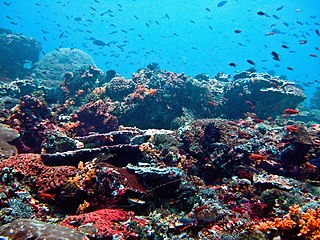
A reef is a ridge or shoal of rock, coral, or similar relatively stable material lying beneath the surface of a natural body of water. Many reefs result from natural, abiotic (non-living) processes such as deposition of sand or wave erosion planing down rock outcrops. However, reefs such as the coral reefs of tropical waters are formed by biotic (living) processes, dominated by corals and coralline algae. Artificial reefs, such as shipwrecks and other man-made underwater structures, may occur intentionally or as the result of an accident. These are sometimes designed to increase the physical complexity of featureless sand bottoms to attract a more diverse range of organisms. Reefs are often quite near to the surface, but not all definitions require this.
The Muschelkalk is a sequence of sedimentary rock strata in the geology of central and western Europe. It has a Middle Triassic age and forms the middle part of the three-part Germanic Trias lying above the older Buntsandstein and below the younger Keuper. The Muschelkalk ("mussel-chalk") consists of a sequence of limestone and dolomite beds.

Mignon Talbot was an American paleontologist. Talbot recovered and named the only known fossils of the dinosaur Podokesaurus holyokensis, which were found near Mount Holyoke College in 1910, and published a scientific description of the specimen in 1911. In 1909 she became the first woman elected to be a member of the Paleontological Society. In the state of New York, she contributed to the Helderbergian crinoids and studied the faunas of Stafford limestone.

Articulata are a subclass or superorder within the class Crinoidea, including all living crinoid species. They are commonly known as sea lilies or feather stars. The Articulata are differentiated from the extinct subclasses by their lack of an anal plate in the adult stage and the presence of an entoneural system. Articulata first appeared in the fossil record during the Triassic period although other, now extinct crinoid groups, originated in the Ordovician.
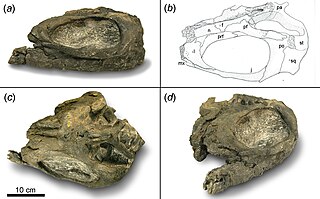
Shastasaurus is an extinct genus of ichthyosaur from the Late Triassic. Specimens have been found in the United States, Canada, and China.
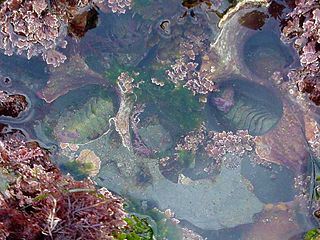
The Mesozoic marine revolution (MMR) refers to the increase in shell-crushing (durophagous) and boring predation in benthic organisms throughout the Mesozoic era, along with bulldozing and sediment remodelling in marine habitats. The term was first coined by Geerat J. Vermeij, who based his work on that of Steven M. Stanley. While the MMR was initially restricted to the Cretaceous, more recent studies have suggested that the beginning of this ecological/evolutionary arms race extends as far back as the Triassic, with the MMR now being considered to have started in the Anisian or the Aalenian. It is an important transition between the Palaeozoic evolutionary fauna and the Modern evolutionary fauna that occurred throughout the Mesozoic.
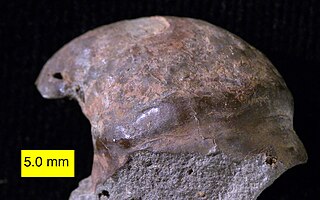
Platyceras is a genus of extinct Paleozoic sea snails, marine gastropod mollusks in the family Platyceratidae. This genus is known from the Silurian to the Middle Triassic periods and especially abundant in the Devonian and Carboniferous. It is the type genus of the family Platyceratidae.
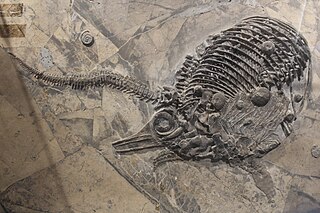
Qianichthyosaurus is an extinct genus of ichthyosaur from the Ladinian and Carnian stages of the Late Triassic epoch. Its fossils have been found in southeastern China, in Carnian rocks of the Falang Formation near Huangtutang, Guizhou. The type species is Qianichthyosaurus zhoui, named by Chun Li in 1999. A second species, Qianichthyosaurus xingyiensis, was named from older (Ladinian) deposits in the Falang Formation in 2013 by Pengfei Yang and colleagues. Complete Qianichthyosaurus fossils are common in the Xiaowa Formation, with both juveniles and pregnant specimens being known; its larger contemporaries, Guizhouichthyosaurus and Guanlingsaurus, are rarer.

The Hosselkus Limestone is an Upper Triassic fossiliferous marine micritic limestone formation that outcrops in Plumas and Shasta Counties, California. It is known for its invertebrate fauna, most notably the many species of shelled cephalopods.
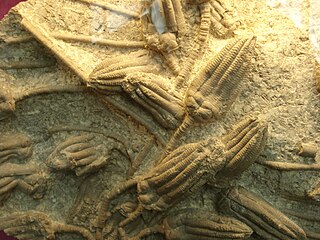
Encrinus is an extinct genus of crinoids, and "one of the most famous". It lived during the Late Silurian-Late Triassic, and its fossils have been found in Europe.
Gogolin Formation – Triassic geologic formation, hitherto named the Gogolin Beds, is the lowermost lithostratigraphical unit of the Lower Muschelkalk in the Silesian-Cracow Upland, underlain by the Upper Buntsandstein carbonates and overlain by the Górażdże Formation carbonates.

Paleontology in Virginia refers to paleontological research occurring within or conducted by people from the U.S. state of Virginia. The geologic column in Virginia spans from the Cambrian to the Quaternary. During the early part of the Paleozoic, Virginia was covered by a warm shallow sea. This sea would come to be inhabited by creatures like brachiopods, bryozoans, corals, and nautiloids. The state was briefly out of the sea during the Ordovician, but by the Silurian it was once again submerged. During this second period of inundation the state was home to brachiopods, trilobites and entire reef systems. During the mid-to-late Carboniferous the state gradually became a swampy environment.

Paleontology in Missouri refers to paleontological research occurring within or conducted by people from the U.S. state of Missouri. The geologic column of Missouri spans all of geologic history from the Precambrian to present with the exception of the Permian, Triassic, and Jurassic. Brachiopods are probably the most common fossils in Missouri.
The Carnian pluvial episode (CPE), often called the Carnian pluvial event, was a period of major change in global climate that coincided with significant changes in Earth's biota both in the sea and on land. It occurred during the latter part of the Carnian Stage, a subdivision of the late Triassic period, and lasted for perhaps 1–2 million years.
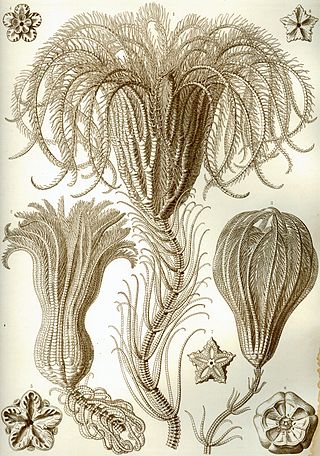
Bourgueticrinida is an order of crinoids that typically live deep in the ocean. Members of this order are attached to the seabed by a slender stalk and are known as sea lilies. While other groups of crinoids flourished during the Permian, bourgueticrinids along with other extant orders did not appear until the Triassic, following a mass extinction event in which nearly all crinoids died out.
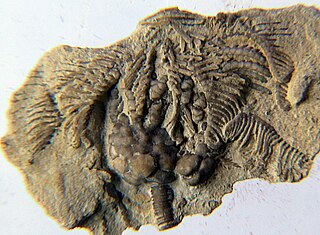
The Camerata or camerate crinoids are an extinct subclass of Paleozoic stalked crinoids. They were some of the earliest crinoids to originate during the Early Ordovician, reached their maximum diversity during the Mississippian, and became extinct during the Permian–Triassic extinction event. Camerates are the sister group of Pentacrinoidea, which contains all other crinoids. The two largest camerate subgroups are the orders Diplobathrida and Monobathrida.

Encrinidae is an extinct family of crinoids belonging to the order Encrinida.
Litorosuchus is a genus of armored, semiaquatic archosauriform reptile from the Middle Triassic of China, closely related to the morphologically similar Vancleavea. It contains one species, L. somnii.
The Xiaowa Formation is a Carnian-age geological formation found in southern China. It is a sequence of limestone and marls from the Carnian stage of the Triassic. Its lower section was previously known as the Wayao Formation or Wayao Member of the Falang Formation. In 2002, the Wayao Member was renamed and raised to the Xiaowa Formation to prevent confusion with an Eocene unit of the same name. Crinoids and marine reptiles are abundant in the Xiaowa Formation, forming a lagerstätte known as the Guanling biota. Ammonoids and conodonts found in the formation constrain its age to the early Carnian. Reptiles of the Guanling biota include ichthyosaurs, thalattosaurs, placodonts, and Odontochelys. Sedimentary events within this formation have been tied to the Carnian Pluvial Event.















